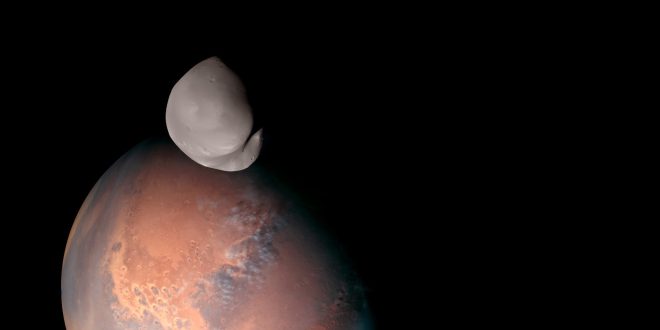The Emirates Mars Mission (EMM), the first interplanetary exploration undertaken by an Arab nation, has unveiled a series of unique and ground-breaking observations of Mars’ smaller moon, Deimos, using all three of its science instruments to ‘advance our fundamental understanding’ of Mars’ most mysterious moon and its larger companion, Phobos. The new observations challenge the longstanding theory that Mars’ moons are captured asteroids and instead point to a planetary origin.
The observations, shared today during a special session at the European Geosciences Union (EGU) General Assembly in Vienna, provide new insights into Deimos’ makeup and structure. These include high resolution images taken during the closest repeated flybys of the moon, as well as the first ever observations made in the extreme and far ultraviolet and the first well-resolved hyperspectral data of Deimos in the thermal infrared. The observations reveal, for the first time, regions on the far-side of Deimos which have never been compositionally investigated. The closest flybys saw Hope pass approximately 100km from Deimos.
“We are unsure of the origins of both Phobos and Deimos,” said Hessa Al Matroushi, EMM Science Lead. “One long-standing theory is that they are captured asteroids, but there are unresolved questions about their composition. How exactly they came to be in their current orbits is also an active area of study, and so any new information we can gain on the two moons, especially the more rarely observed Deimos, has the potential to unlock new understanding of Mars’ satellites. Our close observations of Deimos so far point to a planetary origin rather than reflecting the composition of a type D asteroid as has been postulated.”
It came from Mars
“Much like data acquired of Phobos indicate its composition is not consistent with a captured D-type asteroid, early results from EMIRS observations of Deimos tell a similar story. Both of these bodies have infrared properties more akin to a basaltic Mars than a D-type asteroid such as the Taggish Lake meteorite that is often used as an analog for the spectral properties of Phobos and Deimos.” Said EMIRS Instrument Scientist Christopher Edwards.
Hope has so far made a number of close flybys of Deimos following its transition to a modified orbit using a process known as a ‘Lambert transfer’, a manoeuvre that subtly but consequentially altered Hope’s orbital trajectory to enable Deimos observations while maintaining the mission’s ability to create planet-wide observations of Mars’ atmospheric dynamics.
“We have a unique opportunity with Hope, to characterize the composition, thermophysics, and detailed geomorphology of Deimos with these new observations,” commented Justin Deighan, EMM Deputy Science Lead. “We expect to build a better understanding of both Phobos and Deimos’ origins and evolution and advance our fundamental understanding of these two satellites of Mars.”
While both Mars moons were discovered via telescope in the 19th century, detailed study only became possible during the Space Age. Deimos is the less observed and understood of the two moons, being smaller and orbiting in a wider orbit that completes every 30 hours. Its companion, Phobos, is both larger and orbits closer to Mars, making it more convenient for observation by spacecraft at the Red Planet, most of which reside at even lower altitudes. The distinctively large orbit occupied by Hope around Mars, designed to optimize coverage when studying the planet’s atmosphere, enabled the unique opportunity to study Deimos high detail.
Hope’s first fly-bys of Deimos commenced in late January and early February 2023, with instrument calibration passes and close fly-bys taking place from March onwards supporting high resolution images and observations by the EXI, EMIRS and EMUS instruments on Hope. The closest flybys saw Hope pass approximately 100km from Deimos, the closest approach made by a spacecraft to Mars’ smaller moon since the Viking mission in 1977. Hope will continue a sustained campaign of Deimos fly-bys throughout 2023.
The new findings come as the UAE Space Agency, responsible for the funding and operation of the Emirates Mars Mission, confirmed the extension of EMM’s mission for a further year.
“The remarkable performance of the Mars Hope probe has supported a whole range of new observations in addition to meeting our originally stated science mission goals,” said UAE Space Agency Chair Sarah Al Amiri. “We made new observations in partnership with ESA/JAXA’s BepiColombo spacecraft during our cruise to Mars, encapsulated a range of novel observations of Mars’ auroral displays including never before observed aurora and now have transferred our orbit to not only continue to support our unique observations of Mars’ atmosphere, but also make new observations of Deimos. In the circumstances, Hope exceeding all expectations, we are extending the Emirates Mars Mission for a further year.”
Hope is currently following its planned 20,000 – 43,000 km elliptical science orbit, with an inclination to Mars of 25 degrees, incorporating subtle changes to support its additional Deimos observations. The probe completes one orbit of the planet every 55 hours and captures a full planetary data sample every nine days throughout its mission to map Mar’s atmospheric dynamics.
EMM and the Hope probe are the culmination of a knowledge transfer and development effort started in 2006, which has seen Emirati engineers working with partners around the world to develop the UAE’s spacecraft design, engineering and manufacturing capabilities. Hope is a fully autonomous spacecraft, carrying three instruments to measure Mars’ atmosphere. Weighing some 1,350 kg, and approximately the size of a small SUV, the spacecraft was designed and developed by MBRSC engineers working with academic partners, including LASP at the University of Colorado, Boulder; Arizona State University and the University of California, Berkeley.
The Emirates Mars Mission is studying the Martian atmosphere and the relationship between the upper layer and lower regions and, for the first time, gives the international science community full access to a holistic view of the Martian atmosphere at different times of the day, through different seasons. Science data releases have been taking place every three months, with the information made freely accessible globally to researchers and enthusiasts,
The Hope Probe’s historic arrival at the Red Planet coincided with a year of celebrations to mark the UAE’s Golden Jubilee in 2021.
 UAE BARQ برق الإمارات – نبضك
UAE BARQ برق الإمارات – نبضك


